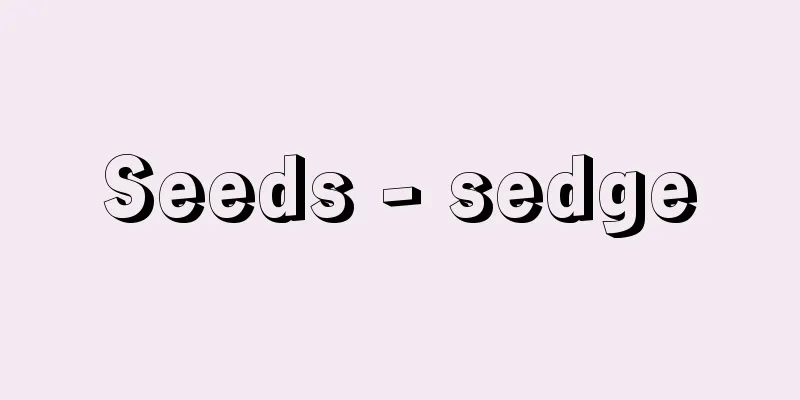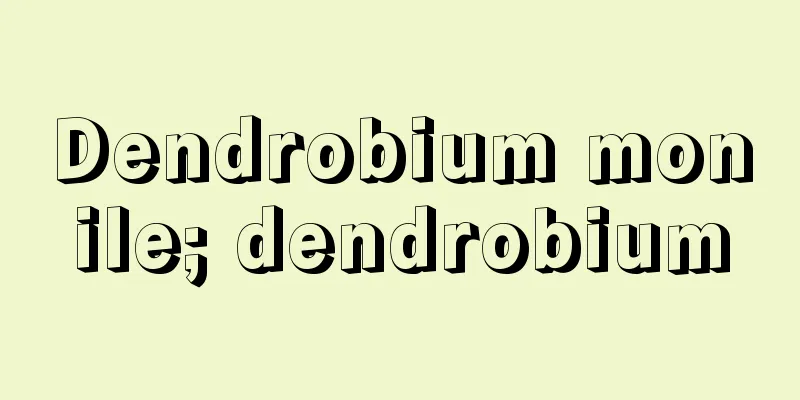Seeds - sedge

|
A reproductive organ found in gymnosperms and angiosperms. It is commonly referred to as a seed. The function of a seed in the life cycle is to scatter the embryo (young sporophyte) contained within it to a location separate from the mother plant, where the embryo will either germinate or remain dormant when conditions are poor. Although seeds and ovules are almost synonymous, mature and dormant ovules are usually referred to as seeds and developing ovules. The three main components of a seed are the seed coat, vegetative tissue, and embryo. [Takashi Yamashita] Seed coatA seed coat is a membrane that surrounds a seed, and is a modified integument of an ovule. There are two types of integument: those with one layer (mostly gymnosperms and angiosperms with sympetalous flowers) and those with two layers (mostly dipetalous flowers and monocotyledons), and in the latter the seed coat also consists of two layers. Sometimes a distinction is made between an outer seed coat and an inner seed coat. In either case, the seed coat usually differentiates into several layers of tissue with different properties. The way in which this differentiation occurs varies greatly depending on the type of plant, so it is not possible to list all of them, but we will give some representative examples. (1) Seed coat tissue In Brassica seeds, the outer and inner seed coats can be distinguished ( ). The outermost layer of the outer seed coat is a layer of mucilage cells containing pectin. When this layer encounters moisture underground, it swells and prepares for germination. Inside is the crushed parenchyma of the outer seed coat. When young, this layer contains several layers of parenchyma cells, but as it ripens, it loses its cytoplasm and is crushed by pressure from inside and outside. The innermost layer of the outer seed coat is sclerenchyma (also called sclerenchyma or mechanical tissue), and the cell walls are hardened by the deposition of lignin (wood element), forming a layer with no gaps. This layer protects the embryo inside and does not allow water to penetrate easily, suppressing germination until conditions are favorable. Water is only allowed to penetrate to the inside after a certain amount of time has passed since the outer cells absorbed enough water. The location of the sclerenchyma varies depending on the type of plant, and it can be found even further outside Brassica, or in the inner seed coat. The degree of hardness also varies depending on the plant. Microorganisms in the soil gradually break down the sclerenchyma, allowing water to seep in. The inner seed coat of Brassica seeds is made up of multiple layers of soft tissue when young, but when fully ripe, all but the innermost layer is crushed. This innermost layer is made up of cells that contain black pigment (pigment cell layer). The area inside this layer is no longer a seed coat, but consists of the aleurone layer, which is the outermost layer of the endosperm (described below), and crushed endosperm tissue with the cytoplasm lost. The above is the seed coat of the Brassica genus, but other commonly found tissues in the seed coats of other plants include crystalline tissue, fibrous tissue, vascular bundles, and tissue made of fleshy parenchyma cells (succulent tissue). The fleshy tissue is usually found on the outer side of the sclerenchyma (ginkgo, magnolia, pomegranate, etc.), and when an animal swallows such a seed, the part inside the sclerenchyma is excreted without being digested, which is thought to help with dispersal. However, some succulent tissues are poisonous. The surface of the seed coat may also contain cuticles, stomata, papillae, and hairs. Cotton fibers are long, thin extensions of epidermal cells. (2) Umbilicus When observing the surface of a seed, a special part called the umbilicus is often found. This is the vestige where the stalk, the base of the ovule, has fallen away from the placenta (such as the seed scale in gymnosperms) in the ovary, and its shape and size vary depending on the species. In seeds produced from antropytic ovules (where the micropyle is on the same side as the stalk), part of the stalk is attached to the seed coat, and often forms a ridge-like protuberance near the umbilicus. In such seeds, tissue near the stalk may protrude during the development of the ovule, covering part or all of the seed coat. This type of structure is called the aril (also called seed coat). In angiosperms, aril is found in Cornus officinalis ( ), water lily, and nutmeg, and is softer and irregularly shaped than the original seed coat. In gymnosperms, fleshy arils are found in yew, Japanese kaya, and dogwood. Some arils are thought to aid in seed dispersal by birds or insects, but their function and origin remain largely unknown. (3) Micropyle There is another special part on the surface of the seed called the micropyle. It is located opposite the hilum in erect ovules and close to the hilum in anthopodium. The micropyle is an opening in the integument of the ovule, where the pollen tube enters in angiosperms and the pollen in gymnosperms at the time of fertilization. However, it is completely closed in the mature seed coat, and it is often difficult to see it from the outside. Special tissues may develop around the micropyle. In castor beans, for example, a soft protrusion called a caruncle forms over the micropyle and secretes lipids ( ). Ants like this part and carry the seeds, so it is said to be useful for dispersal. In dayflower, only the integument around the micropyle hardens early during the development of the ovule. However, the other parts continue to grow, so a constriction forms around the micropyle, and the embryo is inside the constriction ( ). When the seed germinates, the seed coat at the narrow part comes off like a lid and the taproot emerges. Some angiosperms have seeds with wings that extend from the seed coat and fly away on the wind (e.g. Paulownia and Stewartia gracilis). The seeds of gymnosperms such as pine also have wings, but these are caused by part of the tissue of the seed scales that have peeled off and attached to the seed. [Takashi Yamashita] Nutritional TissueThe term endosperm is used to refer to the nutritional tissue in seeds, but it has two meanings. In the broad sense, it refers to all nutritional tissues contained in seeds other than the embryo, while in the narrow sense, it refers to the endosperm of angiosperms. Here, we will use the narrow sense and touch on the nutritional tissues in seeds below. (1) Gymnosperms The vegetative tissue of mature gymnosperm seeds is made up of the female gametophyte (also called the prothallus). The development of the female gametophyte begins with the formation of a megaspore mother cell in the nucellus (the central parenchyma) of a young ovule, which then undergoes meiosis to produce cells of nuclear phase n (half generation). At first, only the nucleus divides repeatedly and no cell wall is formed, a so-called free nuclear division, but a large cell has a vacuole in the center and several thousand nuclei are formed in the periphery. After that, cell wall partitions are formed from the periphery and gradually extend to the center. At this time, several archegonia are formed near the micropyle, in which egg cells are fertilized and embryo development begins, but the female gametophyte continues to grow and enlarge ( ). In mature seeds, the nucellus is completely absorbed by the female gametophyte, and only a thin membrane of dead cells remains. The inner female gametophyte occupies most of the volume of the seed and is filled with storage cells. However, the center is usually consumed by the early embryo, which will be described later, leaving a cavity. In cycads and ginkgo trees, the storage material is mostly starch granules, while in cones such as pines, starch is also found, but the main storage material is aleurone granules, which are made up of lipids and proteins. When ginkgo seeds (ginkgo nuts) fall in the fall, the thick walled tissue of the seed coat is split open to reveal a green, spherical mass of tissue wrapped in a thin membrane. This is the female gametophyte, and this part is edible. It also contains the early embryo, but since it is just after fertilization, it is still very small. After that, when the seed is buried in the ground, the embryo continues to grow by consuming the female gametophyte. Then, just before germination the following spring, the female gametophyte will have been almost completely absorbed. (2) Angiosperms The nutritional tissues of the seeds of angiosperms are the exosperm (exosperm) and the endosperm (endosperm). The exosperm is a part of the tissue of the nucellus that continues to develop after fertilization and stores nutrients, and is found in the Chenopodiaceae and Nymphaeaceae families ( ). In water lilies, the exosperm makes up most of the volume of a mature seed, and its cells are enlarged and contain starch granules. The thin-film endosperm is located near the micropyle, and the embryo is enclosed within it. The endosperm is the main nutrient tissue found in almost all angiosperms. The female gametophyte of angiosperms is called an embryo sac, and usually produces eight free nuclei. The two central nuclei combine to form the polar nucleus. Of the two sperm nuclei in the pollen tube, one combines with an egg cell near the micropyle to form an embryo, and the other combines with this polar nucleus to form the endosperm. This is called double fertilization. Therefore, the endosperm is in the 3n nuclear phase (triploid), and is considered to be an independent plant body that is different from both the sporophyte and the gametophyte. There are three types of development of the endosperm: the free karyotype (Brassicaceae, Poaceae, etc.), in which a vacuole is formed in the center and many free nuclei are formed around the periphery; the cytotype (Asteraceae, etc.), in which a cell wall partition is formed from the beginning; and the marsh type (Liliaceae, etc.), in which a cell wall is formed during the first division and then free nuclear division occurs. In the orchid family, the endosperm degenerates after a few nuclear divisions, producing seeds with little nutrition. Even in the case of free-karyotic or marsh-type endosperms, if they develop relatively late, cell walls begin to form from the periphery. The endosperm of the Fabaceae and Salicaceae families develops to the stage where cell walls are formed, but the embryo then rapidly enlarges and absorbs the endosperm completely. This is the state that is referred to when plant descriptions say that "seeds have no endosperm." In the mature endosperm of coconut palms, tissue made of cells forms on the periphery, and the center is filled with huge vacuoles. This is what is called coconut milk. In the endosperm of the Poaceae family, when mature, the cells are packed all the way to the center, and starch grains are placed inside them. Starch is the most common storage material in the endosperm, and the outermost layer of the endosperm is usually the aleurone layer, which contains protein. However, the endosperm of the lily and palm families does not contain starch, but instead consists of lipids, proteins, and hemicellulose (a carbohydrate that, together with cellulose, makes up the cell membrane) in the thickened cell walls. [Takashi Yamashita] EmbryoThe sporophyte that develops from a fertilized egg to a certain extent is called an embryo, but there are differences in its development between gymnosperms and angiosperms. (1) Gymnosperms The fertilized egg of a gymnosperm first undergoes free nuclear division, then forms a cell wall in part, which becomes a long, thin row of cells that extends into the female gametophyte. This stage is called the early embryo. The early embryo extends and twists as it dissolves the gametophyte tissue, and produces many branches. Eventually, a mass of meristematic tissue (embryo) forms at the tip of each branch, and these begin to take the shape of a young plant, complete with cotyledons and a taproot. Thus, many young plants are produced within a single ovule, and usually only the one that develops the fastest remains until it is fully ripe, and the others are absorbed by it. (2) Angiosperms The fertilized egg of angiosperms first divides and forms a mass of tissue, from which it immediately begins to produce a single plant. However, when we look at the embryo inside a fully ripe seed, the stage of development of the embryo varies depending on the species. In the case of the Ranunculaceae family, such as Anemone annua, the embryo inside the seed when it falls is either a fertilized egg that has not yet divided, or merely an undifferentiated mass of a few cells. After the seed is buried in the ground, the embryo develops by absorbing nutrients from the endosperm. The embryo inside a fully ripe seed of the Orchidaceae family is in a similar state, but in this case, since it does not have nutrient tissue, it cannot germinate on its own, and instead germinates and grows by absorbing nutrients from the hyphae of a symbiotic fungus in the ground. However, in most other plants, the embryo develops further inside the ovule, and after producing the various organs of the young plant, such as the cotyledons, shoot apex, hypocotyl, and taproot, it goes into hibernation. In the legume family, the embryo develops until it has completely absorbed the endosperm, and the two cotyledons swell to occupy most of the seed's volume and store proteins, lipids, etc. In most seeds, the embryo enters the taproot with the tip facing the micropyle. Therefore, the dormant hypocotyl and taproot cells are flattened in the longitudinal direction, but when they absorb water, they swell in the longitudinal direction, causing the hypocotyl and taproot to elongate rapidly, breaking through the seed coat near the micropyle and coming out. Incidentally, many of the things that are treated as "seeds" at seed stores and nurseries should be called "fruits" from an academic perspective. For example, seeds in the Asteraceae family are actually achenes (mono-ovary, single-species fruits) and the outer hard shell is the pericarp derived from the ovary wall, which functions as a seed coat. There is only one seed inside the pericarp, and the original seed coat is in the form of a thin membrane. Also, what are called seeds in the Poaceae family are actually caryopsis (a type of achene) and the seed coat is attached to the back side of the ovary wall and cannot be peeled off separately. [Takashi Yamashita] © Satoshi Shimazoe Cross-section of the seed coat of Brassica genus (Fig. A) © Satoshi Shimazoe Longitudinal section of a Cornus officinalis seed (Fig. B) © Satoshi Shimazoe Castor bean seed and cross section (Fig. C) © Satoshi Shimazoe Vertical section of a dayflower seed (Fig. D) © Satoshi Shimazoe Longitudinal section of ginkgo ovule and seed (Fig. E) © Satoshi Shimazoe Cross-section of a Nymphaeaceae seed (Fig. F) ©Shogakukan "> Seed dispersal method Source: Shogakukan Encyclopedia Nipponica About Encyclopedia Nipponica Information | Legend |
|
裸子植物および被子植物がもつ生殖器官の一つ。日常的には種(たね)とよぶことが多い。生活環のうえでの種子の機能は、中に包まれている胚(はい)(若い胞子体)を母(ぼ)植物とは別の場所に散布し、そこで胚を発芽させるか、または条件の悪いときには休眠させておくことである。なお、種子と胚珠とは同義に近いが、普通、成熟して休眠状態にあるものを種子、発達中のものを胚珠とよぶ。 種子のおもな構成要素は、種皮、栄養組織、胚の三つである。 [山下貴司] 種皮種皮とは種子の周囲を覆う皮膜をいい、胚珠における珠皮が変化したものである。珠皮は1枚のもの(多くは裸子植物と被子植物合弁花類)と2枚のもの(多くは離弁花類と単子葉類)とがあり、後者では種皮もこれに対応して、2枚からなる。ときには、外種皮と内種皮とに区別する。いずれの場合でも、種皮はさらに何層かの性質の異なる組織に分化しているのが普通である。その分化の仕方は植物の種類によってきわめて多様であるため、すべてを示すことはできないが、代表的な例をいくつかあげることとする。 (1)種皮の組織 アブラナ属の種皮では、外種皮と内種皮が区別できる()。外種皮の最外層はペクチンを含む粘液細胞層である。この層は地中で水分に出会うと膨潤して、発芽の準備をする。その内側には、押しつぶされた外種皮の柔組織がある。これは若いときには数層の柔細胞であったが、完熟するとともに細胞質が抜け、内外からの圧力で押しつぶされたものである。外種皮の最内層は厚壁組織(厚膜組織、機械組織ともいう)で、細胞壁にはリグニン(木材素)が沈着して堅くなり、すきまのない層をつくっている。この層は中にある胚を保護するとともに、容易には水を浸透させず、条件がよくなるまで発芽を抑制する働きをもっており、外側の細胞が十分に吸水して一定の時間がたったあとに、初めて内側に水を浸透させる。厚壁組織の存在する場所は植物の種類によって異なり、アブラナ属よりもさらに外側の場合もあれば、内種皮に存在する場合もある。また、堅さの程度も植物によってさまざまである。なお、地中の微生物によって厚壁組織が徐々に分解され、水が浸透することも多い。アブラナ属の内種皮は、若いときには多層の柔組織からなっているが、完熟すると最内層以外は押しつぶされる。この最内層は黒色の色素を含む細胞からできている(色素細胞層)。この層より内側はもはや種皮ではなく、内胚乳(後述)の最外層であるアリューロン層(糊粉(こふん)層)と、細胞質が抜けてつぶれた内胚乳の組織となっている。 以上がアブラナ属の種皮であるが、他の植物の種皮でよくみられる組織として、結晶を含む組織、繊維状の組織、維管束、多肉質の柔細胞からなる組織(多肉組織)などがある。多肉組織は厚壁組織よりも外側にあるのが普通で(イチョウ、モクレン、ザクロなど)、このような種子を動物が飲み込むと、厚壁組織よりも内側は消化されずに排泄(はいせつ)され、散布に役だつとされる。しかし、なかには有毒な多肉組織も多い。また、種皮の表面にはクチクラ(角皮)、気孔、パピラ(乳頭状突起)、毛などが存在することがある。ワタの繊維は表皮細胞が細長く伸び出したものである。 (2)へそ(臍) 種子の表面を観察すると、へそとよばれる特別な部位のあることが多い。これは、胚珠の基部である珠柄が子房内の胎座(裸子植物では種鱗(しゅりん)など)から離れて落ちた痕跡(こんせき)であり、その形と大きさは種類によってさまざまである。倒生胚珠(珠孔が珠柄と同じ側にあるもの)からできた種子では、珠柄の一部が種皮に沿着しており、へその近くに稜(りょう)のような隆起となっていることが多い。こうした種子では、胚珠の発達中に珠柄付近の組織が張り出し、種皮の一部または全部を覆うことがある。このような構造を仮種皮(種衣ともいう)とよぶ。被子植物ではキブシ()のほか、スイレン、ニクズクなどにみられ、仮種皮は本来の種皮よりも柔らかく、不規則な形となる。裸子植物ではイチイ、カヤ、イヌマキなどに多肉質の仮種皮がみられる。仮種皮のなかには、鳥や昆虫による種子散布に役だつものがあると考えられているが、その機能と起源については、まだ不明な点が多い。 (3)珠孔 種子の表面にはもう一つの特別な部位として珠孔がある。その位置は直生胚珠のものではへその反対側、倒生胚珠のものではへそのすぐ近くである。珠孔は胚珠における珠皮の開口部で、受精のときに被子植物では花粉管が、裸子植物では花粉が侵入した場所である。しかし、成熟した種皮では完全に閉鎖され、外見からでは確認するのが困難なことが多い。こうした珠孔の周りに特別な組織が発達することがある。トウゴマなどでは、珠孔を覆ってカルンクルcaruncleとよばれる柔らかい突起ができ、脂質を分泌する()。アリがこの部分を好み、種子を運搬するため、散布に役だつといわれる。また、ツユクサでは胚珠の成長の途中で珠孔の周囲の珠皮だけが早く堅くなる。しかし、他の部分はその後も成長を続けるため、珠孔付近にくびれができ、胚はそのくびれの中に入っている()。発芽のときにはくびれた部分の種皮が蓋(ふた)のように外れ、そこから主根が出てくる。 被子植物には種皮の一部が張り出して翼(よく)となり、風で飛ぶものがある(キリ、ヒメシャラなど)。裸子植物のマツなどの種子にも翼がついているが、これは種鱗の組織の一部がはがれて種子に付着したものである。 [山下貴司] 栄養組織種子における栄養組織として胚乳の語が使われるが、これには二つの意味がある。広義には種子に含まれる胚以外のすべての栄養組織をさすが、狭義には被子植物の内胚乳をさしている。ここでは狭義としてとらえ、以下、種子における栄養組織に触れる。 (1)裸子植物 裸子植物の成熟した種子の栄養組織は、雌性配偶体(前葉体ともいう)からできている。雌性配偶体の発達は、まず、若い胚珠の珠心(中央を占める柔組織)の中に大胞子母細胞ができ、これが減数分裂して核相n(半数世代)の細胞ができる。この細胞は、初めのうちは核だけが繰り返して分裂し、細胞壁をつくらない、いわゆる自由核分裂を行うが、大きな1個の細胞の中央には液胞があり、周辺部には数千個の核ができる。その後、周辺部から細胞壁の仕切りができ、しだいに中央にまで及んでいく。このころ、珠孔に近い部分に数個の造卵器がつくられ、その中で卵細胞が受精して胚発生が始まるが、雌性配偶体はその後も成長と肥大を続ける()。成熟した種子では、珠心は雌性配偶体によって吸収し尽くされ、死んだ細胞からなる薄膜状の組織として残るだけである。その内側の雌性配偶体が種子の体積の大部分を占め、ここに貯蔵細胞が詰まっている。ただし、中央部は後述する初期胚によって消費され、空洞ができているのが普通である。貯蔵物質はソテツやイチョウではデンプン粒が多く、マツなどの球果類ではデンプンもあるが、脂質とタンパクからなるアリューロン粒が主体である。イチョウの種子(銀杏(ぎんなん))が秋に落下するとき、種皮の厚壁組織を割ると、中から薄膜に包まれた緑色で球形の組織塊が現れる。これが雌性配偶体であり、この部分を食用とする。このなかには初期胚も含まれているが、受精直後であるため、まだきわめて小さい。その後、種子が地中に埋没すると、胚は雌性配偶体を消費して成長を続ける。そして、翌春の発芽の直前には、雌性配偶体はほとんど吸収し尽くされることとなる。 (2)被子植物 被子植物の種子の栄養組織には外胚乳(外乳)と内胚乳(内乳)とがある。外胚乳は、珠心の組織の一部が受精後にもさらに発達して栄養を貯蔵するようになるもので、アカザ科、スイレン科などにみられる()。スイレンでは成熟した種子の体積の大部分を外胚乳が占め、その細胞は肥大して、中にデンプン粒をもっている。珠孔寄りの部分に薄膜状の内胚乳があり、胚はその中に包まれている。 内胚乳は、被子植物のほとんどすべてがもつもっとも主要な栄養組織である。被子植物の雌性配偶体は胚嚢(はいのう)とよばれ、通常は8個の自由核をつくる。そのうちの中央にある2個の核が合体して極核となる。花粉管のもっている2個の精核のうち、1個は珠孔寄りにできた卵細胞と合体して胚をつくり、他の1個はこの極核と合体して内胚乳をつくる。これを重複受精という。したがって内胚乳は核相3n(三倍体)であり、胞子体とも配偶体とも異なる独立した植物体であると考えられている。内胚乳の発達様式には、初め中央に液胞ができ、周辺部に多数の自由核をつくる自由核型(アブラナ科、イネ科など)、初めから細胞壁の仕切りができる細胞型(キク科など)、第1回の分裂のときに細胞壁をつくり、そのあとに自由核分裂をする沼生(しょうせい)型(ユリ科など)の三つがある。ラン科などでは、内胚乳は数回の核分裂を行うのみで退化し、栄養をほとんどもたない種子をつくる。自由核型や沼生型の内胚乳であっても、比較的あとまで発達する場合には周辺部から細胞壁をつくり始める。マメ科やオモダカ科の内胚乳は細胞壁をつくる段階にまで発達するが、その後は胚が急速に肥大して内胚乳は吸収し尽くされてしまう。植物の解説などで、「種子に胚乳はない」と書かれているのはこのような状態をさしている。また、ココヤシの成熟した内胚乳では、周辺部に細胞からできた組織ができ、中央部は巨大な液胞で埋まる。これがココナッツミルクとよばれるものである。イネ科の内胚乳では、成熟すると中心部まで細胞が詰まり、その中にデンプン粒を入れている。内胚乳の貯蔵物質としてもっとも一般的なのがデンプンであり、内胚乳の最外層は普通、タンパクを含むアリューロン層となる。しかし、ユリ科やヤシ科の内胚乳にはデンプンがなく、脂質とタンパク質、および肥厚した細胞壁についているヘミセルロース(セルロースとともに細胞膜を構成する炭水化物)となる。 [山下貴司] 胚受精卵がある程度発達した胞子体を胚とよぶが、裸子植物と被子植物では、その発達に違いがみられる。 (1)裸子植物 裸子植物の受精卵は、初めに自由核分裂を行ったあと、一部に細胞壁をつくり、この部分が細長い細胞列となって雌性配偶体の中に伸び出す。この段階のものを初期胚という。初期胚は配偶体の組織を溶かしながら曲がりくねって伸び、多くの分枝を行う。やがてそれぞれの枝の先端に分裂組織の塊(胚)ができ、これがそれぞれ子葉や主根などを備えた幼植物の形をつくり始める。したがって、1個の胚珠の中に多数の幼植物ができることになるが、通常は、このうちもっとも早く発達したものだけが完熟時まで残り、他はこれによって吸収される。 (2)被子植物 被子植物の受精卵は、まず細胞分裂をして組織の塊を形成し、これからただちに1個の幼植物をつくり始める。しかし、完熟時の種子に入っている胚をみた場合、胚の発達段階は、種類によってさまざまである。ニリンソウなどのキンポウゲ科の場合でみると、種子が落下したときに入っている胚はまだ分裂していない受精卵であるか、または少数の細胞からなる未分化な塊にすぎず、種子が地中に埋没してから胚は内胚乳から栄養をとって発達する。また、ラン科の完熟種子中の胚も同様な状態であるが、この場合は栄養組織がないので自力で発芽することはできず、地中にある共生菌の菌糸から栄養をとって発芽、成長する。しかし、他のほとんどの植物では胚は胚珠中でさらに発達し、子葉・茎頂・胚軸・主根などの幼植物の諸器官をつくったのち、休眠する。マメ科では胚は内胚乳を吸収し尽くすまで発達し、2個の子葉が肥大して種子の体積の大部分を占め、タンパク質、脂質などを貯蔵するようになる。ほとんどの種子で、胚は主根の根端を珠孔に向けて入っている。このため、休眠中の胚軸と主根の細胞は、長軸方向から扁圧(へんあつ)された形となっているが、これが吸水すると長軸方向に膨らむことから胚軸と主根が急激に伸び、珠孔付近の種皮を押し破って外に出る。 なお、種苗店などで「種子」として扱われるもののなかには、学問的にみると「果実」とよぶべきものも多数含まれている。たとえば、キク科などで種子というのは、実際には痩果(そうか)(単子房、単種の果実)であり、外側の堅い殻は子房壁に由来する果皮で、機能的にはこれが種皮のかわりをしている。果皮の中にはただ1個の種子があり、本来の種皮は薄膜状となっている。また、イネ科で種子とよぶのは、実際には穎果(えいか)(痩果の一種)であり、種皮は子房壁の裏側に合着し、別々にはがすことができなくなっている。 [山下貴司] ©島添 敏"> アブラナ属の種皮の断面〔図A〕 ©島添 敏"> キブシの種子の縦断面〔図B〕 ©島添 敏"> トウゴマの種子と縦断面〔図C〕 ©島添 敏"> ツユクサの種子の縦断面〔図D〕 ©島添 敏"> イチョウの胚珠と種子の縦断面〔図E〕 ©島添 敏"> スイレン科の種子の断面〔図F〕 ©Shogakukan"> 種子の散布方法 出典 小学館 日本大百科全書(ニッポニカ)日本大百科全書(ニッポニカ)について 情報 | 凡例 |
<<: Resin - Jushi (English spelling) resin
Recommend
Breath sounds
…Physicians listen to these sounds over the chest...
Azeotropic mixture - eutectic mixture
When distilling a mixed solution, the composition...
control configured vehicle
…Abbreviation for control configured vehicle. It ...
Takiginou - Firewood Noh
(1) Shinto Noh originated from the offering of fi...
Accounting chief - Kanjogashira
〘Noun〙① = Kanjo Bugyo (Accountant Magistrate) ② ※B...
show
For example, the French word représentation, whic...
Koya Kano
?-1673 A painter from the early Edo period. The s...
Green vegetable wholesaler - Aomono Donya
...Famous vegetable markets in the early modern p...
Sudden hearing loss
What kind of disease is it? ●Main symptoms and pro...
Yun Shou-ping (English spelling)
Born: 1633 [Died] Kangxi 29 (1690) A Chinese paint...
Liberal Arts College
Liberal arts college is a general term for private...
Kayano-sain Temple
…In 1159 (Heiji 1), she became Kamo Saiin, and se...
Squalus
…A general term for marine fishes belonging to th...
Hishikari [town] - Hishikari
A former town in Isa County in northern Kagoshima ...
Biography of women
In addition to the single-part series of biograph...

![Toshichi [Hot Springs] - Toshichi](/upload/images/67cc4fe486404.webp)

![Nijo [town] - Nijo](/upload/images/67cc6dafd2936.webp)





